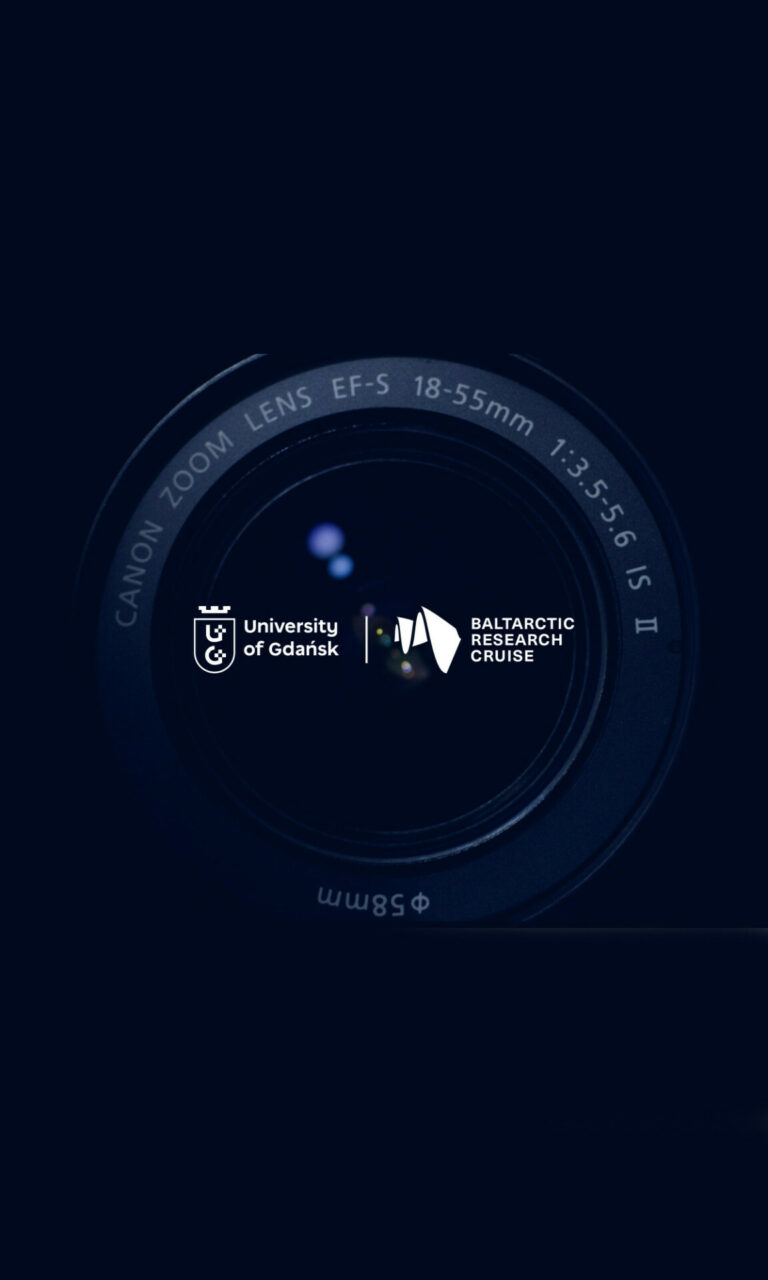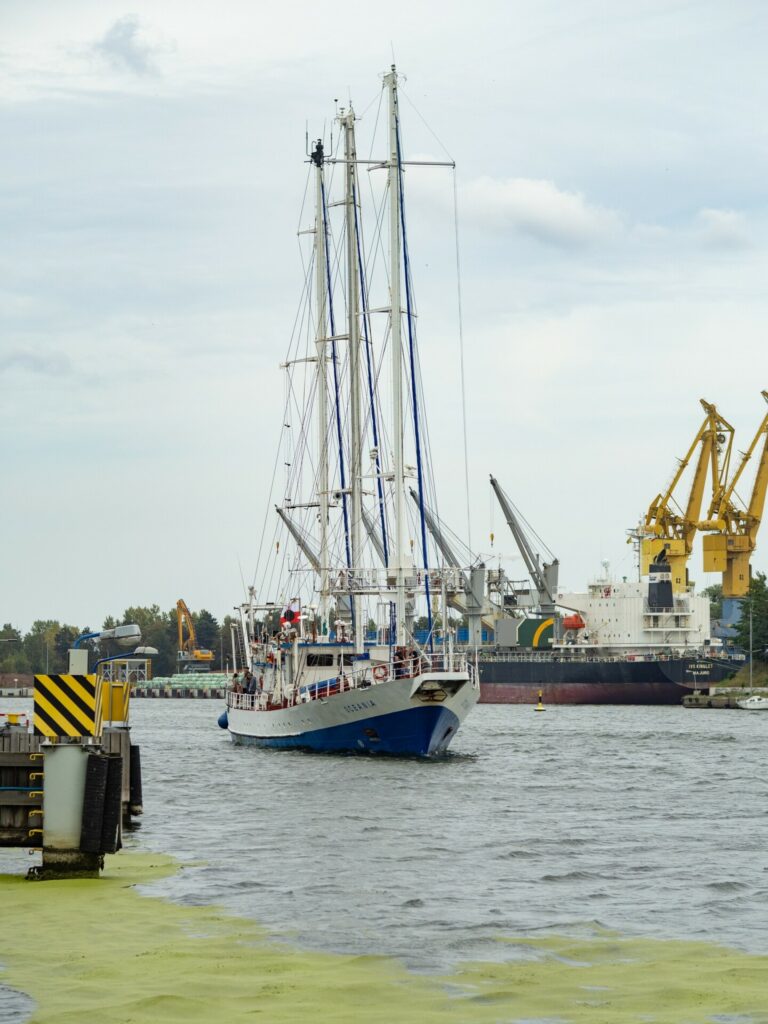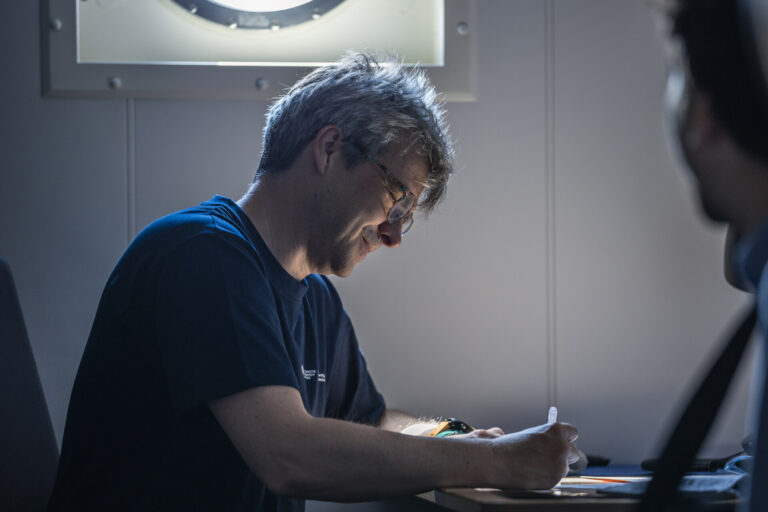Friday morning, the fifth day of the expedition. Behind the stern disappears the huge war memorial in Kiel, ahead are six days of sailing along the coasts of Sweden and Norway to Bergen, a city tucked away in the land of fjords.
A short lecture on the physics of sailing. Toward the ship the wind is true, calculated in knots. Right now, for example, it’s a pleasant three degrees on the Beaufort scale, or more or less 10 knots (about 20 kilometres per hour). But on board we feel the apparent wind – the real wind together with that caused by the movement of the ship. That is, if we were sailing against the wind at our speed of 10 knots, on deck we’d be getting a headwind of 20, already a decent five bft. But since the wind is now blowing toward Oceanografer’s broad ass, the wind abates and we have a sunny beach on deck.
It’s gorgeous, a dream of a day at sea like a postcard.
Which allows us not to think about the weather forecast, according to which tomorrow evening in the Danish straits – and then north of Denmark – awful conditions await us, wind, rain and waves reinforced by the Atlantic swell. Well, we’ll worry if there’s anything to worry about.
In Kiel we spent a busy day, the scientific team gave tours of the ship to the verge of fainting, the art team (one representative) went to the university, to conduct a workshop on narrative. Among the participants, mainly people from science departments, oceanographers, biologists, geographers. Traditionally, as with people outside the industry, they were surprised to learn that there was some science behind art too, that it’s not waiting for magical inspiration, but knowledge, certain tools and even – let’s not be afraid of the word – mathematical formulas.
I’ve always had the sciences as a string of mistakes, as a result of which one arrives at a good solution. So I explain that the most important element of a story, if it is to be attractive, is failure. The hero goes on an expedition, has adventures, suffers defeat, but rises to symbolic victory and transformation. The more painful the defeat, the more satisfying the victory for the audience. Exactly this is the way of science, I say, you set out to explore, nothing comes out, but you learn from these mistakes and make a discovery.
They look at each other with strange faces.
I ask what’s going on.
Here’s what turns out. The world of science is not free from the widespread propaganda of success. Journals want to publish successful research, preferably spectacular, everyone is interested in progress, the result, eureka – not the path leading to eureka. And if, as a result of the research, the eureka has not happened, then the string of failures does not interest anyone at all. Even if the data flowing from the failures would be invaluable to someone. This is a problem especially in medicine, where a new drug that doesn’t work on rheumatism can be a miracle cardiac drug, but no one will know about it, because, after all, it doesn’t work on rheumatism.
That is, we are still working on the issue of plot attractiveness in the sciences.
An observation: perhaps scientists need to be taught narrative techniques, but they certainly don’t need to be trained in narrative per se, these people talk incessantly, suddenly my gleefully loud bohemians look like a bunch of snotty introverts. Seriously, just looking in their direction is enough for them to start teaching.
The scene happens at a formal dinner.
Me: what do you do, esteemed gentleman?
The esteemed gentleman: I study seafloor sediments.
Me: oh, that’s fascinating.
The esteemed gentleman regales me with a story from which I have eyes like saucers. How, on an old drilling ship bought back from American oilmen, together with Texans eating two steaks each for breakfast, he drills three kilometers into the bottom off the coast of Africa to pull samples of successive layers of bottom from there. Because once something sinks to the ocean floor, it stays there, pressed down by the weight of the water, so a lot can be read from the contents of successive layers of this cake. For example, shells of creatures that like cold water mean that the water was cold then. Sand from the Sahara – that there was a strong wind from Africa. Volcanic ash – that traces of some great eruption settled on the water and sank to the bottom. The most important information, of course, is how the Earth’s climate was shaped.
Me: unusual, and how far back can you look like this? A hundred years? A thousand?
The esteemed gentleman: one hundred and twenty million years.
Curtain.
I mentioned the war memorial, visible far out to sea, with which Kiel greets sailors. Well, there was a Kriegsmarine base and a submarine factory here, meticulously bombed by Allied air raids, so the city wrote its page in wartime history on the side of both aggressors and victims. The air raids were not limited to the port, so the city gives the impression of having been built in the 1960s, and more emphasis was placed on functionality than architectural spectacularity during the reconstruction. As if to say, Kiel is, well, likable.
Perhaps I would be more inclined to reflect on its plight if I were not from Warsaw. Europe, there are no journeys here that are not journeys through history. As Kurt Vonnegut wrote: so it goes.
Meanwhile, we headed north. Kiel was the southernmost point of the expedition, the sun went down at 9:48 p.m., rose at 4:48 a.m. That is, the night lasted an even seven hours. So where we are heading now will not be night at all.
r/v Oceanograf
BaltArctic Research Cruise, Day 5
June 7, 2024
Najdłuższa noc
Pozory i rzeczywistość • Zła prognoza • Propaganda sukcesu • Jak steki pozwalają spojrzeć milion lat wstecz • Bywa i tak
Piątkowe przedpołudnie, piąty dzień wyprawy. Za rufą znika ogromny pomnik wojenny w Kilonii, przed nami sześć dni żeglugi wzdłuż wybrzeży Szwecji i Norwegii do schowanego w krainie fiordów Bergen.
Króciutki wykład z fizyki żeglugi. W stronę statku wieje wiatr rzeczywisty, liczony w węzłach. Na przykład teraz są to przyjemne trzy stopnie w skali Beauforta czyli plus minus 10 węzłów (ok. 20 kilometrów na godzinę). Ale na pokładzie czujemy wiatr pozorny – rzeczywisty razem z tym spowodowanym ruchem statku. Czyli gdybyśmy płynęli pod wiatr z naszą prędkością 10 węzłów, na pokładzie urywałoby nam głowy 20, już porządne pięć bft. Ale ponieważ teraz Oceanografowi wieje w jego szeroką dupkę, to wiatr się znosi i na pokładzie mamy słoneczną plażę.
Jest wspaniale, marzenie o dniu ma morzu jak z pocztówki.
Co pozwala nam nie myśleć o prognozie pogody, wedle której jutro wieczorem w cieśninach duńskich – a potem na północ od Danii to już w ogóle – czekają na nas parszywe warunki, wiatr, deszcz i fale wzmocnione atlantyckim rozkołysem. Cóż, będziemy się martwić, jak będzie się czym martwić.
W Kilonii spędziliśmy pracowity dzień, ekipa naukowa do granic omdlenia oprowadzała wycieczki po statku, ekipa artystyczna (sztuk jeden) pojechała na uniwersytet, prowadzić warsztaty z narracji. Wśród uczestników głównie osoby z wydziałów ścisłych, oceanografowie, biolodzy, geografowie. Tradycyjnie, jak to u ludzi spoza branży, zdziwienie, że za sztuką też się kryje jakaś nauka, że to nie czekanie na magiczne natchnienie, tylko wiedza, pewne narzędzia, a nawet – nie bójmy się tego słowa – matematyczne wzory.
Zawsze miałem nauki ścisłe za pasmo błędów, w wyniku których dochodzi się do dobrego rozwiązania. Tłumaczę zatem, że najważniejszym elementem opowieści, jeśli ma ona być atrakcyjna, jest wlaśnie porażka. Bohater wyrusza na wyprawę, przeżywa przygody, ponosi klęskę, ale powstaje ku symbolicznemu zwycięstwu i przemianie. Im boleśniejsza porażka, tym bardziej satysfakcjonujące dla widowni zwycięstwo. Dokładnie jest to droga nauki, mówię, wyruszacie na badania, nic nie wychodzi, ale uczycie się z tych błędów i dokonujecie odkrycia.
Patrzą po sobie z dziwnymi minami.
Pytam, co jest grane.
Otóż co się okazuje. Świat nauki nie jest wolny od powszechnej propagandy sukcesu. Czasopisma chcą publikować badania zakończone sukcesem, najlepiej spektakularnym, wszystkich interesuje postęp, wynik, eureka – a nie droga do eureki prowadząca. A jeśli wskutek badań do eureki nie doszło, to już pasmo klęsk w ogóle nikogo nie interesuje. Nawet jeśli płynące z niepowodzeń dane byłyby dla kogoś bezcenne. Jest to problem zwłaszcza w medycynie, gdzie nowy lek niedziałający na reumatyzm może być cudownym lekiem kardiologicznym, ale nikt się o tym nie dowie, bo przecież nie działa na reumatyzm.
Czyli ciągle pracujemy nad zagadnieniem fabularnej atrakcyjności w naukach ścisłych.
Spostrzeżenie: być może naukowców trzeba uczyć technik narracyjnych, ale na pewno nie trzeba ich szkolić z narracji jako takiej, gadają ci ludzie bez przerwy, nagle moja radośnie głośna bohema wygląda jak banda smętnych introwertyków. Serio, wystarczy spojrzeć w ich stronę, żeby zaczęli nauczać.
Scena w czasie oficjalnej kolacji.
Ja: a szanowny pan czym się zajmuje?
Szanowny pan: badam osady na dnie morskim.
Ja: och, to fascynujące.
Szanowny pan raczy mnie opowieścią, od której mam oczy jak spodki. Jak na odkupionym od amerykańskich nafciarzy starym statku wiertniczym, razem z jedzącymi na śniadanie po dwa steki teksańczykami wwierca się trzy kilometry w dno u wybrzeży Afryki, aby wyciągać stamtąd próbki kolejnych warstw dna. Ponieważ jeśli raz coś opadnie na dno oceanu, to już tam zostaje, przyciśnięte ciężarem wody, dlatego z zawartości kolejnych warstw tego sękacza można wyczytać wiele. Na przykład skorupki żyjątek lubiących zimną wodę oznaczają, że wtedy woda była zimna. Piasek znad Sahary – że mocno wiało ze strony Afryki. Popiół wulkaniczny – że ślady jakiejś wielkiej erupcji osiadły na wodzie i opadły na dno. Najważniejsza informacja to oczywiście taka, jak i w wyniku jakich czynników kształtował się ziemski klimat.
Ja: niezwykłe, i jak daleko możecie tak spojrzeć wstecz? Sto lat? Tysiąc?
Szanowny pan: sto dwadzieścia milionów lat.
Kurtyna.
Wspomniałem o widocznym daleko z morza pomniku wojennym, którym Kilonia wita żeglarzy. Otóż znajdowała sie tutaj baza Kriegsmarine i fabryczka ubootów, pieczołowicie bombardowane przez alianckie naloty, zapisało więc miasto swoją kartę w wojennej historii zarówno po stronie agresorów, jak i ofiar. Naloty nie ograniczały się do portu, dlatego miasto sprawia wrażenie wybudowanego w latach 60. i większy nacisk położono w czasie odbudowy na funkcjonalność, niż spektakularność architektury. Jakby to powiedzieć, jest Kilonia taka, no, sympatyczna.
Być może bardziej byłbym skłonny do zadumy nad jej ciężkim losem, gdybym nie pochodził z Warszawy. Europa, nie ma tutaj podróży, które nie byłyby podróżami przez historię. Jak pisał Kurt Vonnegut: bywa i tak.
Tymczasem kierunek: północ. Kilonia była najbardziej na południe wysuniętym miejscem wyprawy, słońce zaszło o 21.48, wstało o 4.48. Czyli noc trwała równo siedem godzin. Tam dokąd zmierzamy nocy nie będzie w ogóle.
R/V Oceanograf
BaltArctic Research Cruise, Dzień 5
7 czerwca 2024





